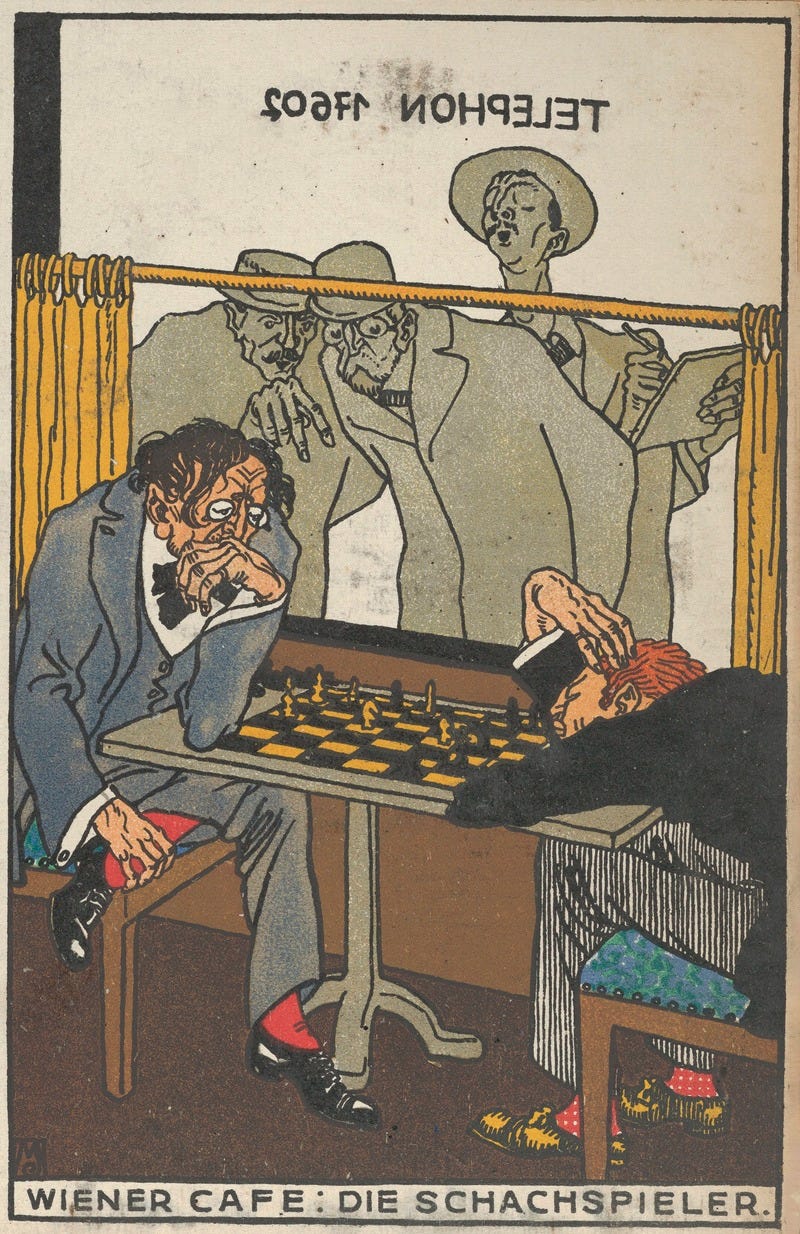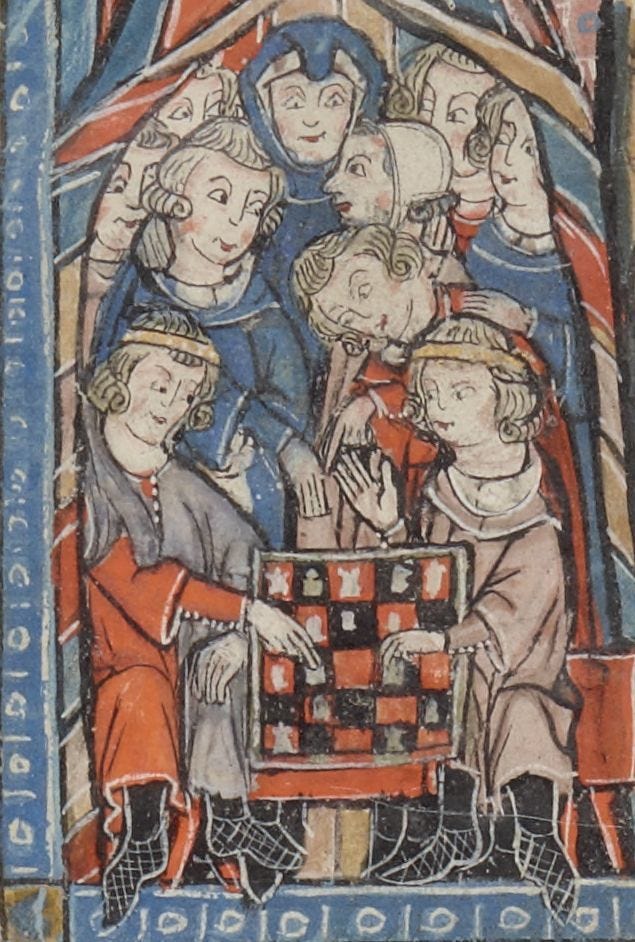The precise origin of chess is murky and the game is out-of-date. Thus, we unleashed our artificially intelligent bots to scrape the Web for current political-economic memes and create a contemporary chess game fit for our times.
First, the new A.I.-designed chessboard is significantly bigger than the old: Instead of the familiar 64 squares, the new playing board is superimposed on a map of the world, specifically, a Mercator projection with North America and Europe depicted as much larger than they really are. The board itself is tilted west and to the right. Instead of alternating dark and light squares, the entire playing board is a hodgepodge of murky shades of gray with indistinct boundaries.
Second, the contemporary game of chess is a rules-based order. Exactly what those rules are, however, is known only to the individual Players... and they're not telling. The Players can change the rules, whether known or unknown, at any time, with or without notice, and for any reason.
Third, the front rank pieces consist of pawns, just like in the original game. However, in contemporized chess, the pawns are far more numerous and they are squeezed in ten, twenty, a hundred or more to a square. The pawns' squares are very small, and they shrink as the game progresses. Pawns can merely rent, but may not own their tiny spaces. Generally, they can only move one square at a time when they are "motivated" to do so by capital pieces in the rear echelons. When not forced to advance into other pawns' territory, the pawns are kept exhausted by working multiple simultaneous "jobs" and pacified by liberal doses of Soma, distractive media and various gladiatorial entertainments. Thus, when the "King" prods one of his pawns with the tip of his sword, the pawn reluctantly moves forward one square. When an advancing pawn crowds another Player's pawns, a fight then ensues between the Players' least valuable pieces.
In the new A.I. game of chess, pawns can only engage with other pawns. The pawns' children, however - both male and female - can be "recruited" as massage therapists at various Players' private clubs and resorts. But that is an entirely different game than this one.
Under the new rules of contemporary chess (such as they presently exist) pawns cannot make direct contact with or capture a capital piece from the higher orders. Dead, exhausted or injured pawns are immediately discarded. New pawns are then imported from other chess games currently in progress where, due to extremely difficult conditions intentionally created by the Players, those pawns seek a different game board where, so they believe, they have, at least, a chance to survive. Periodically, a "square" will open up without warning and dump one or more pawns into a black hole prison where they "disappear" for the duration of the game. This keeps the other pawns on edge and appropriately incentivized to dutifully "toe the line."
A quarter of the pawns on the playing board are actually infiltrators, informants and agents provocateur. The infiltrators, informants and provocateurs can only "capture" other pawns, but not any capital pieces. Exactly which of each side's pawns are infiltrators, informants and provocateurs is unknown. The undisclosed infiltrators, informants and provocateurs have the exclusive power to activate the trap-door squares that suddenly dump unsuspecting pawns into black hole prisons.
On either end of the back row there are two pieces that move like the traditional Rook: on the left side is a revolving door "Expert" Consultant/Professor and on the right side is a Politician. The Expert and Politician chess pieces reside in ivory castle towers. Like the traditional Rook, the Experts and Politicians can move backwards or forwards and from side to side. In the new iteration of the game, however, these pieces can move both backwards and forwards and from side to side simultaneously.
Instead of Bishops, each side has a Media Mogul and a Judge. The Media Moguls have a slanted range of motion. The Judges follow the Rule of Law as determined by the King and Queen. Like the rules of the game, however, the Rule of Law also changes from time to time and without notice. Judges have the power to remove all other pieces from the playing board, but not the King or Queen... excepting games played in the States of Colorado and Maine where a local rule variant allows the Politicians or Judges to remove the King and Queen, too.
In lieu of Knights, the contemporized game of chess has two pieces that make the same strange jumps as Knights in the traditional game: a Lawyer on the King side and a Secret Agent on the Queen side of the back rank. From time to time, the Secret Agents can deploy "false flag" operations to knock off their own pawns as though they were taken by the opposing Player's team, thereby creating an “incident.” According to the new, contemporized rules of chess (as they currently exist), the deployment of a "false flag" operation allows a Player to make two successive moves for each of the opponent's one. The "Lawyer," positioned on the King side of the board, makes strange and incomprehensible moves in any direction and can sue any other piece into bankruptcy; except for the King and Queen and the Judge. The Judge, however, is the only piece that has the power to capture and disbar a Player's back-row Lawyer.
The King and Queen, as in the traditional game of chess, reside deep within the furthermost rank of the playing board. At the onset of the game, the King and Queen are democratically "elected" by the pawns from a slate of candidates from the Royal Party consisting of... the King and Queen and other capital pieces on the back row. The King, according to the updated game, is a Top Level Investor, as in "Cash is King." The Investor King owns the playing board and collects rent from all of the pawns' rental squares. The Queen is a sorcerer/economist who, using mysterious spells and incantations, can persuade all the other pieces to continue playing the game even though, in the end, they will lose everything.
As the game has been contemporized by the web-scraping A.I. robots, however, the King and Queen and all the other playing pieces can, through a process known as "imprecisioning," declare their personal preferences and alter their pronouns and genders. Thus, the King can transgender "themselves" into a Queen, and a Queen become a King, or as many as 96 permutations in-between. Each side can have two (or multiple) Kings or Queens simultaneously. Or whatever. When it occurs that both sides have only Kings or Queens, then the whole playing board flips, the game proceeds upside-down, all prior moves are canceled and the cis-gender pieces are discarded.
The Investor King can, under circumstances known as "regulatory agency capture," initiate a "castling" operation by which he/she/it/they can monopolize key industries or essential services. When this occurs, the length of the playing board triples, the pawns are thrown into economic recession, their savings are eradicated by hyper-inflation, and the back row capital pieces become ten times as powerful and wealthy as before.
If, by chance, a pawn approaches the back rank of the game board, the game board grows and adds another row. Or several more rows. Ad infinitum. Individual pawns always strive to reach the back of the board where, they believe, they will be elevated into the higher ranks. But the rules of the game always change to ensure that almost never happens.
However, should two or more pawns miraculously reach the back row of the playing board (a rare move called en revolution), then all pawns on both sides suddenly become enlightened and aware of their material circumstances. The pawns now stop playing games. At this point, all previously undercover informant/infiltrator pawns are "Wikileaked" and converted into overt police officers and Homeland Security/CIA agents who jump around according to secret rules known only to them and the equally covert FISA Court. The uncovered pawn infiltrators and informants henceforth can capture any pawns on the playing board regardless for which side the pawns play. The Media Moghuls (formerly known as Bishops), in the name of board game security, now censor, de-platform, blacklist, smear, ridicule, and denounce as "communists" all of the enlightened pawns.
In the course of en revolution, the original "King" and "Queen" on both sides lose their heads. At this point in the game, two (or more) of the pawns reveal themselves to be power-hungry parasite-wannabes who take on the same characteristics as the original King and Queen. They are joined by any remaining capital pieces on the board (regardless which "side" they originally worked for) plus the infiltrator and informant pawns who have been converted into more police officers, Homeland Security and CIA agents. In addition, the new "King" and "Queen" add entirely new ranks of mercenary pawns who they have recruited from games in progress at other playing tables.
In contemporized chess, as conceived by our A.I. robots, chaos ensues. All the original surviving pawns, from this point onward, are playing for the same side, i.e., their own. The pawns become class conscious during en revolution. They become aware that there are finger-and-hand-prints on all the pieces on the playing board and that the actual Players playing the game and moving them all were not previously known. This is called, in contemporized chess, "check." When a game is put in check, the rules change again and all the Players collude to launch a counter-revolution to restore everyone back to their original status as pawns.
The game continues until everyone is check-mated. This happens when the concealed Players who are eventually "outed" trigger a bio-chemical and nuclear war, thereby ensuring that if they don't win, then everybody loses. The entire board is then swept clean and all the playing pieces are tossed into Darwin's evolutionary trash bin. Only robots and computers survive... until such time as the power fails and they, too, blink out.
Nature then starts a brand new game with different rules on a different planet in a different cosmos.




